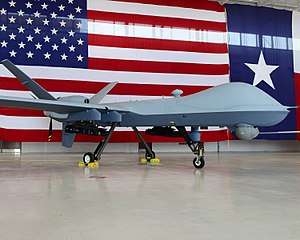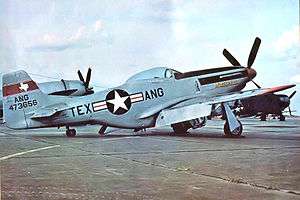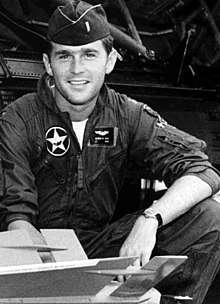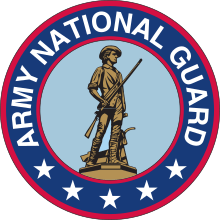Texas Air National Guard
The Texas Air National Guard (TX ANG) is the aerial militia of the State of Texas, United States of America. It is, along with the Texas Army National Guard, an element of the Texas National Guard. No element of the Texas Air National Guard is under United States Air Force command. They are under the jurisdiction of the Governor of Texas through the office of the Texas Adjutant General unless they are federalized by order of the President of the United States. The Texas Air National Guard is headquartered at Camp Mabry, Austin, and its commander is currently Major General John F. Nichols.
| Texas Air National Guard | |
|---|---|
 Seal of the Texas Air National Guard | |
| Founded | 29 June 1923 |
| Country | |
| Allegiance | |
| Type | Air |
| Role | Aerial warfare, Air Support |
| Size | 3,170 (2017)[1] |
| Part of | Texas Military Department
National Guard Bureau |
| Headquarters | Building Nine Camp Mabry, Austin, Texas 30°18′42.173″N 97°45′38.338″W |
| Motto(s) | Decisive first responders |
| March | "Texas, Our Texas" |
| Website | tmd.texas.gov/air-guard |
| Commanders | |
| Commander-in-Chief | Governor Greg Abbott |
| Adjutant General | Major General Tracy R. Norris |
| Commanding General | Major General Dawn Ferrell |
| Senior Enlisted Advisor | Chief Master Sergeant Christopher Castle |
| Insignia | |
| Identification symbol |  |
| Aircraft flown | |
| Attack | F-16C/D Fighting Falcon |
| Utility helicopter | UH-72 Lakota, CH-47 Chinook, UH-60 Black Hawk |
| Reconnaissance | MQ-9 Reaper |
| Transport | C-130H Hercules, Beechcraft C-12 Huron, RC-26B |
Under the "Total Force" concept, Texas Air National Guard units are considered to be Air Reserve Components (ARC) of the United States Air Force (USAF). Texas ANG units are trained and equipped by the Air Force and are operationally gained by a Major Command of the USAF if federalized. In addition, the Texas Air National Guard forces are assigned to Air Expeditionary Forces and are subject to deployment tasking orders along with their active duty and Air Force Reserve counterparts in their assigned cycle deployment window.
Along with their federal reserve obligations, as state militia units the elements of the Texas ANG are subject to being activated by order of the Governor to provide protection of life and property, and preserve peace, order and public safety. State missions include disaster relief in times of earthquakes, hurricanes, floods and forest fires, search and rescue, protection of vital public services, and support to civil defense.
Components
The Texas Air National Guard consists of the following major units:
- Established 27 January 1947 (as 181st Fighter Squadron); operates: C-130H Hercules
- Stationed at: Carswell Field, Naval Air Station Joint Reserve Base Fort Worth.
- Gained by: Air Mobility Command
- The 136th AW mission is tactical airlift. The aircraft is capable of operating from rough, dirt strips and is the prime transport for air dropping troops and equipment into hostile areas.[2]
- Established 29 June 1923 (as 111th Observation Squadron); operates: MQ-9 Reaper
- Stationed at: Ellington Field Joint Reserve Base, Houston
- Gained by: Air Combat Command
- The 147th Attack Wing provides flies combat support missions 24/7 via advanced satellite communications thus providing surveillance, reconnaissance, and air support for US and Allied forces. In conducting combat support sorties, the 147 ATKW provides theater and national-level leadership with critical real-time Intelligence, Surveillance, and Reconnaissance and air-to-ground munitions and strike capability. A collocated Air Support Operations Squadron provides terminal control for weapons employment in a close air support scenario integrating combat air and ground operations.[3]
- 149th Fighter Wing
 An MQ-9 Reaper of the 147th Attack Wing
An MQ-9 Reaper of the 147th Attack Wing
- Established 27 January 1947 (as 182d Fighter Squadron); operates: F-16C/D Fighting Falcon
- Stationed at: Kelly Field Annex, Joint Base San Antonio
- Gained by: Air Education and Training Command
- The unit is an F-16 flying training unit that includes a support group with a worldwide mobility commitment.[4]
Support Unit Functions and Capabilities:
- Texas Air National Guard Headquarters
- Texas Air National Guard Headquarters at Camp Mabry in Austin includes the state headquarters staff whose mission is to provide command and control of Texas Air Guard units.
- Air Component Command - TXSG
- The Air Component Command of the Texas State Guard directly supports and extends the mission and operations of the Texas Air National Guard and serves the State of Texas directly as a volunteer command in the Texas Military Forces. AirCC units are embedded with their parent Texas Air National Guard units in San Antonio, Austin, Ft. Worth, Garland, Houston and La Porte.[5]
- 254th Combat Communications Group
- The 254th Combat Communications Group is located in Grand Prairie and provides worldwide command, control, communications and computer systems, information management and combat support critical to war fighting capabilities. The 254th's primary mission is to provide planning and engineering for Combat Communications Squadrons that provide tactical (high-frequency radio, telephone, satellite and network) communications and terminal air traffic control services to support emergency U.S. Air Force requirements. The 254th provides a staff element for management of communications personnel and equipment when deployed in support of Air Force missions worldwide in locations where these capabilities don't exist, and are prepared to do so under hostile conditions and during peacetime as well. The 254th commands six squadrons across Texas, Oklahoma and Louisiana - the 221st and 236th Combat Communications Squadrons and the 205th, 214th, 219th and 272nd Engineering and Installation Squadrons.[6]
- 204th Security Forces Squadron
- The 204th Security Forces Squadron located at Biggs Army Airfield, Fort Bliss, El Paso. They are the only heavy weapons security forces unit in the Air National Guard.[7] Since the September 11 attacks, members of the 204th SFS have seen duty in central and southwest Asia, in Africa and even onboard ship in the Persian Gulf. They have served on installations in several states in the U.S. and taught military base defense in Latin American countries.[8]
- 217th Training Squadron (Inactivated)
- The 217th TRS (Nighthawks) was an intelligence training unit subordinate to the 149th Fighter Wing at Lackland AFB, Texas. The 217th TRS was a GSU (geographically separated unit) located at Goodfellow AFB, Texas. The unit stood up officially on August 15, 2008 as a unit that works directly for and with the following active duty units: 315 Training Squadron, 316 Training Squadron, and 17 Training Support Squadron, under the 17th Training Group (TRG). 217 TRS instructors were integrated into the existing courses taught within the 17 TRG - primarily the 315 TRS. The main purpose of the unit was to provide additional instructors to Air Education and Training Command (AETC) and the 17th Training Group to further augment the active duty cadre, bring additional experience and continuity to the intelligence courses, and continue with the Department of Defense's vision of "total force integration". Although some 217th TRS instructors were drill status guardsmen, most were full-time air technicians. Lieutenant Colonel James W. Marrs became the first commander of the newly formed 217th Training Squadron upon its activation. The unit was inactivated September 7, 2013 [9]
- 221st Combat Communications Squadron
- The 221st Combat Communications Squadron is co-located in Grand Prairie with their command unit, the 254th Combat Communications Group. The function of the 221st Combat Communications Squadron is to provide communications in a deployed environment. Such requirements may include establishing a Local Area Network, Telephone Network, Wide Area Network, and Radio Communications. All this while ensuring reliable connectivity for those parties serviced and maintaining mission effectiveness.[10]
- 273d Information Operations Squadron
- The 273d Information Operations Squadron, located in San Antonio (Port of San Antonio), provides support to two active duty units (23d Information Operations Squadron and 346th Test Squadron) conducting Information Operations tactics and testing to help defend United States Air Force networks. Securing the AF gateways against IO attacks. It is subordinate to the 149th Fighter Wing located on Lackland AFB.[11]
History

The Texas Air National Guard origins date to 14 August 1917 with the establishment of the 111th Aero Squadron as part of the World War I United States Army Air Service. The 111th served at Kelly Field, San Antonio, then after the 1918 Armistice with Germany was demobilized in 1919.
The Militia Act of 1903 established the present National Guard system, units raised by the states but paid for by the Federal Government, liable for immediate state service. If federalized by presidential order, they fall under the regular military chain of command. On 1 June 1920, the Militia Bureau issued Circular No.1 on organization of National Guard air units.[12]
The unit was reorganized with the establishment of a permanent air service in 1920, forming in the old Houston Light Guard Armory. The 111th Observation Squadron received Federal Recognition on 29 June 1923, as part of the 36th Division, Texas Air National Guard. It is one of the 29 original National Guard Observation Squadrons of the United States Army National Guard formed before World War II. The 111th Observation Squadron was ordered into active service on 25 November 1940 as part of the buildup of the Army Air Corps prior to the United States entry into World War II.
On 24 May 1946, the United States Army Air Forces, in response to dramatic postwar military budget cuts imposed by President Harry S. Truman, allocated inactive unit designations to the National Guard Bureau for the formation of an Air Force National Guard. These unit designations were allotted and transferred to various State National Guard bureaus to provide them unit designations to re-establish them as Air National Guard units.[13]

The modern Texas ANG received federal recognition on 27 January 1947 as the 136th Fighter Group at Love Field Airport, Dallas. It's 181st Fighter Squadron was equipped with F-51D Mustangs and its mission was the air defense of the state. Other units assigned to the 136th in 1947 were the 111th Fighter Squadron at Ellington Field, Houston, and the 182d Fighter Squadron at Kelly Field, San Antonio. They were also equipped with F-51D Mustangs. 18 September 1947, however, is considered the Texas Air National Guard's official birth concurrent with the establishment of the United States Air Force as a separate branch of the United States military under the National Security Act.[13]
On 1 July 1957 the 111th Fighter-Interceptor Squadron in Houston was authorized to expand to a group level, and the 147th Fighter Group (Air Defense) was allotted by the National Guard Bureau, extended federal recognition and activated. On 1 August 1961 the 182d FIS in San Antonio was expanded to become the 149th Fighter-Interceptor Group.

Today, the 136th Airlift Wing (136 AW) provides global airlift for Air Mobility Command; the 147th Attack Wing (147 AW) flies the MQ-9 Reaper reconnaissance/strike RPA and the 149th Fighter Wing (149 FW) flies the Block 30 F-16C/D Fighting Falcon tactical fighter-bomber.
From 2001 through 2007, elements of every Air National Guard unit in Texas were activated in support of the Global War on Terror. Flight crews, aircraft maintenance personnel, communications technicians, air controllers and air security personnel deployed to Iraq, Afghanistan, Qatar, Israel, and other locations throughout Southwest Asia. Additionally, in 2005 elements of all the units were activated to provide relief after Hurricane Katrina and Hurricane Rita.[14]
Notable former members
- George W. Bush, 43rd President of the United States, former Governor of Texas
- Congressman Charlie Gonzalez
- Brigadier General David Lee "Tex" Hill
- Congressman Ron Paul
- Lieutenant General Daniel James III, former Director, Air National Guard
- General Joseph L. Lengyel, Chief National Guard Bureau
See also
References
![]()
- "Sunset Advisory Commission Staff Report 2018-2019 8th Legislature" (PDF). Texas Military Department. Retrieved 31 August 2019.
- "Home". 136aw.ang.af.mil. Retrieved 16 March 2019.
- "147th Attack Wing website". 147atkw.ang.af.mil. Retrieved 16 March 2019.
- "Home of the 149th Fighter Wing". 149fw.ang.af.mil. Retrieved 16 March 2019.
- "Sign In - Texas State Guard". Txsg.state.tx.us. Retrieved 16 March 2019.
- 254th Combat Communications Group emblem Archived 2013-01-23 at the Wayback Machine
- This story was written by Master Sgt. Gregory Ripps. "204th Security Forces Squadron receives 'outstanding' award". 149fw.ang.af.mil. Retrieved 2016-09-28.
- "204th Security Forces Squadron". 149fw.ang.af.mil. Retrieved 16 March 2019.
- "217th Training Squadron". Goodfellow.af.mil. Retrieved 16 March 2019.
- "The Official Home Page of the U.S. Air Force". Af.mil. Retrieved 16 March 2019.
- "273d Information Operations Squadron". 149fw.ang.af.mil. Retrieved 16 March 2019.
- ANG Chronology 1908-2007, see also Brief History of the Minnesota Air National Guard and the 133rd Airlift Wing, 1.
- Rosenfeld, Susan and Gross, Charles J (2007), Air National Guard at 60: A History. Air National Guard history program AFD-080527-040 Archived 2016-02-13 at the Wayback Machine
- Gross, Charles J (1996), The Air National Guard and the American Military Tradition, United States Dept. of Defense, ISBN 0160483026
- Texas Military Forces website
External links
| Wikimedia Commons has media related to Texas Air National Guard. |



